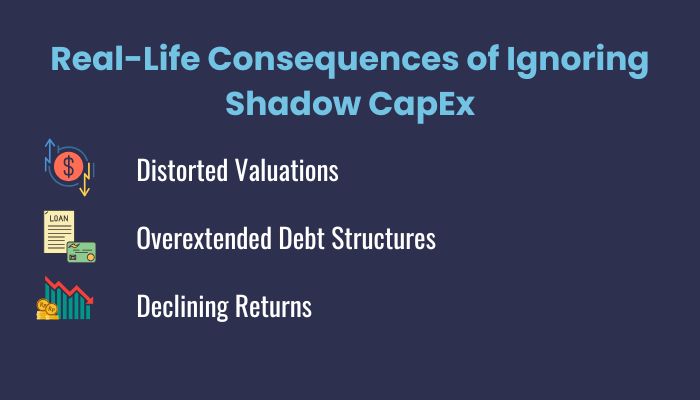


Have you ever leaned back from your spreadsheet, wondering why your nice, neat model just doesn’t match up to the realities of a private investment? Maybe your projections about free cash flow look great on paper—until you start digging into expenses that aren’t clearly tagged as “capital expenditures.” That’s the moment you might be encountering the dreaded “Shadow CapEx.” It’s those unassuming but often significant costs that can undermine your careful analysis and possibly chip away at your real returns.
Below, we’ll get into what Shadow CapEx is, why it creeps into models, and how to protect yourself—especially if you’re working within a private investment platform. Think of this article as a friendly heads-up on how to keep surprise expenditures from cutting into your profits.
Picture this scenario: You’re reviewing a small manufacturing company’s financials. They post a modest capital expenditure figure each quarter. Yet you notice a separate line item for “equipment upgrades and repairs” in operating expenses that, somehow, always seems to spike in the months after the main CapEx is recorded. If you’re scratching your head, you’re likely staring at a form of Shadow CapEx—those capital-like costs that don’t appear on the standard CapEx line.
Sometimes it’s inadvertent: The accounting department might just be following a certain rule set or classification system. Other times, there’s a deliberate effort to keep the official CapEx figure low, so the company’s financials look a bit more appealing to lenders or investors. Either way, it’s a real expense, and you don’t want to ignore it.
Think of routine “maintenance” that quietly becomes a near-constant project. Or software “subscriptions” that are really paying for a substantial technological overhaul. Anytime you’re dealing with big one-off charges or repeated lumps that extend the life of an asset, that’s usually capital spending in disguise.
For publicly traded firms, you often have access to analyst calls, extensive annual reports, and a long history of SEC filings. While Shadow CapEx can still appear, you at least have more documents to cross-reference. In private deals, your information primarily comes from whatever the company decides to provide. That opacity can lead to some surprises.
Without big regulatory requirements, it’s much easier for a private company to group expenses in unusual ways—intentionally or not. That means you might see a shiny, understated CapEx line without realizing there are additional capital-like costs floating around.
Private investments often emphasize the upside—maybe you’re banking on the company’s growth rate or thinking about flipping the business after some operational improvements. But if your real capital costs are higher than projected, that upside might fade quickly.
If you discover these hidden costs too late, you can’t just hop onto a public market to offload your stake. You might be locked into a private vehicle that takes months (or even years) to unwind.
One of the first things I personally look for is a mismatch between depreciation and what the company calls “regular maintenance.” If a firm’s annual depreciation is $500,000, yet their maintenance expense (recorded in operating expenses) is driving up costs year after year and easily surpassing that figure, a red flag starts waving in my mind.
Sometimes, what was categorized as CapEx in one quarter morphs into a “maintenance fee” the next. Consistency is key, so if they keep moving these items around in the statements, that might hint at Shadow CapEx.
Spikes in operating expenses that suddenly appear under harmless-sounding labels like “equipment tune-up” or “infrastructure refresh” are worth examining. If you keep seeing them every year, that’s not really “one-off,” is it?
This might sound straightforward, but if you bring up “Shadow CapEx” in a conversation with the CFO or controller, you’ll get a sense of how open or dismissive they are about it. Their reaction can be quite telling.
It’s one thing to acknowledge the concept, but it’s another to understand its repercussions. I once looked at a small tech startup that seemed undervalued based on the “official” numbers. Then I realized they were plowing a surprising amount of cash into data-center improvements—treated entirely as “operating expenses.” Suddenly, their free cash flow wasn’t nearly as appealing.

The best defense against Shadow CapEx’s sneaky effects is building a bit of skepticism—or prudence—into your analysis. If you see a consistent track record of $1 million in CapEx per year, consider padding that figure by 10–20% in your model if you suspect any underreporting.
Run scenarios where CapEx is higher than what’s on paper by a decent margin. Observe how that affects your free cash flow. If the deal still looks decent under these scenarios, you’re probably on safer ground.
An older firm with outdated equipment might need more upkeep. That cost might be recorded in unexpected line items. Meanwhile, tech companies dealing with servers or software might keep labeling crucial upgrades as “R&D,” even if those upgrades are actually capital investments.
If you have data on similar companies or a rough industry average, see how the numbers line up. Substantial departures—whether higher or lower—could be a sign you need to investigate further.
When you’re part of a private investment platform (or if you run one), you may be responsible for sharing opportunities with other investors. You want to make sure you catch these hidden costs before presenting a deal to anyone else.
Even if you find Shadow CapEx, don’t assume the deal is off the table. Sometimes, it’s an honest oversight or a quirk of accounting—but it should certainly factor into your negotiation.
Maintaining a watchful eye for Shadow CapEx isn’t just about playing defense. It can also help you spot unique opportunities. If everyone else is just skimming the financials but you’re the one who notices that real CapEx is understated, you can:

Nate Nead is the Founder and Principal of HOLD.co, where he leads the firm’s efforts in acquiring, building, and scaling disciplined, systematized businesses. With a background in investment banking, M&A advisory, and entrepreneurship, Nate brings a unique combination of financial expertise and operational leadership to HOLD.co’s portfolio companies. Over his career, Nate has been directly involved in dozens of acquisitions, spanning technology, media, software, and service-based businesses. His passion lies in creating human-led, machine-operated companies—leveraging AI, automation, and structured systems to achieve scalable growth with minimal overhead. Prior to founding HOLD.co, Nate served as Managing Director at InvestmentBank.com, where he advised middle-market clients on M&A transactions across multiple industries. He is also the owner of several digital marketing and technology businesses, including SEO.co, Marketer.co, LLM.co and DEV.co. Nate holds his BS in Business Management from Brigham Young University and his MBA from the University of Washington and is based in Bentonville, Arkansas.